Google Pixel XL Review: Taking Android to New Heights
Despite a less-than-thrilling design, the Pixel is a crowning achievement in Google’s quest to marry software and hardware.
Why you can trust Tom's Guide
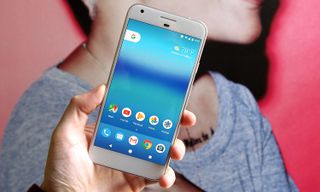
Editors' Note: This review focuses on the Pixel XL. Read our Pixel review for a more in-depth look at Google's 5-inch phone.
After watching other manufacturers attempt to deliver a pure Android experience with the Nexus for years, Google has taken total control with the Pixel. This phone is an unadulterated take on not just Google's software, but also its hardware. In fact, this handset feels like the very essence of the company.
At $649 for the Pixel and $769 for the larger Pixel XL, these premium phones deliver the latest version of Android (Nougat) and a powerful new Google Assistant that outshines Siri. But you also get some pretty fantastic hardware, including Qualcomm's fastest processor, a gorgeous AMOLED display available in either 5- or 5.5-inch sizes, and one of the best cameras we've seen on a smartphone yet.
Even though the Pixel's appearance doesn't impress, almost everything else is firmly on point, and this phone puts Google neck and neck with Samsung's Galaxy S7 Edge in the running for the best Android phone on the market.
Camera: One of the best shooters yet
One of the most surprising things about the Pixel is its camera, because after boldly saying its phone sports the best rear camera yet, Google almost entirely delivered. While I won't quite go so far as to say it's the undisputed king, the Pixel is in a dead heat with Samsung's Galaxy S7 as the top smartphone for photography.
Highlights include auto HDR+ photos that top even those from the S7 and take much less time to process than they do on the Nexus 6P and other Android phones.

In a shot across the Hudson River of Lower Manhattan, the Pixel captured bluer skies and more details in the buildings than the S7 did.

The comparison wasn't as cut and dry when we shot an indoors close-up of a cute crafted birdy: Although the Pixel's shot had more detail, the S7's image featured much warmer and more pleasing colors. Still, the advantage belongs to Google.

However, at night out by the USS Intrepid, the S7 earned a pretty convincing win over the Pixel XL with a shot that was sharper, less grainy and better exposed than anything Google's phone could produce.
In general, the S7 still holds an edge in focus speeds, thanks to its dual-pixel autofocus speeds and wider f/1.7 lens, while the Pixel's exquisite HDR+ mode, and even more detailed bright-light shots hit back hard.
The Pixel is in a dead heat with the Galaxy S7 as the top smartphone for photography.
In front, the Pixel's 8-megapixel selfie cam is pretty proficient, too, as it repeatedly captured sharp detail with good exposure in a number of conditions.
In addition, the Pixel produces stunning 4K 30-frames-per-second video and electronic image stabilization that often outdoes the optical stabilization found on other smartphones. It's not perfect, and it sometimes borders on being too smooth. But with a little practice and finesse, you can get shake-free clips that will make people think you spent money on an expensive gimbal.
Google Assistant: It's really helpful
Google Assistant is the company's answer to Siri and Cortana, and it succeeds at harnessing the power of Google's search and knowledge base and at making it easy to use. Google Assistant makes the company's Google Now more powerful by giving it access to resources both on the phone and on the internet.
Just as important, because the phone is always listening for you to say "OK, Google" or to touch and hold the home button, it responds very quickly. (In comparison, Apple's Siri can be a bit slow sometimes.)
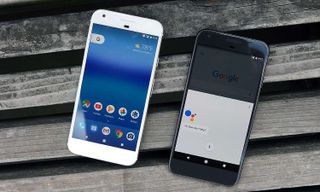
Google Assistant is an expert at searching the net for nearby restaurants or coffee shops, or looking inside your phone for the photos that you shot last week or last month. You can tell it to set reminders, play a video in YouTube or send a text, all using natural, nonrobotic voice commands.
For example, when I asked the Google Assistant to help me book a table at Sushi Nakazawa, the phone asked me to confirm the size of my party and the time I wanted to go. Then it swiftly whisked me off to the OpenTable app to check on availability. However, when I asked Siri the same thing, she had a much harder time understanding, and it took several more attempts and rephrased questions before she understood my request.
Unlike Google Now, Google Assistant has a new custom chat interface that makes it easier to keep track of both your questions and Google's answers. It feels more like a real conversation and less like bouncing questions off a robot.
Lastly, if you swipe right on the home screen, there's a revamped place for Google suggestion cards, which makes it easier to see stories and news that might be pertinent to you.
Google also has plans for future updates that will let you control home appliances, such as, your lights or thermostat, simply by talking to the assistant.
Design: Not hot
For what is supposed to be the star of Google's new homegrown hardware division, the Pixel's design is disappointing.
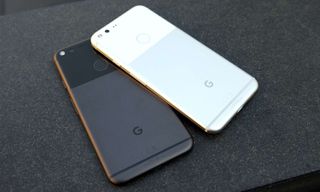
It's dull, it's derivative and the back is downright ugly. The only real saving grace is the existence of the "really blue" color option, which helps bring some life to the Pixel's otherwise uninspired appearance.
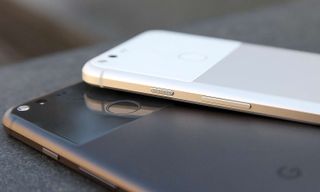
If you don't mind having a case on your device, you should probably opt for one of Google's $40 customizable Live Cases to hide the Pixel's frumpy facade.
MORE: Best Smartphones on the Market Now
There's no getting around it: From the front, the Pixel looks like a bad iPhone clone. The Pixel's Leno-like bottom chin is especially off-putting. We wish Google had included capacitive touch buttons beneath the screen. I'm not a big fan of the headphone jack's placement on top, either.

Around back, the glass panel up top looks like a cheap cover-up to hide that Google had to saw open a hole to squeeze in the Pixel's camera and fingerprint sensor. The best thing I can say about the Pixel's backside is that at least the camera sits flush against the phone.
The standard 5-inch Pixel (5.66 x 2.74 x 0.33 inches and 5.04 ounces) is a tiny bit bigger than the Samsung Galaxy S7 (5.61 x 2.74 x 0.31 inches and 5.36 ounces), while the 5.5-inch Pixel XL (6.1 x 2.98 x 0.33 inches and 5.9 ounces) is larger and heftier than the Samsung S7 Edge (5.94 x 2.85 x 0.3 inches and 5.53 ounces).
Display: Rich colors and deep blacks, but could be brighter
The Pixel XL features a glorious 5.5-inch 2560 x 1440 display while its smaller sibling has a slightly less dense 5-inch full-HD display.
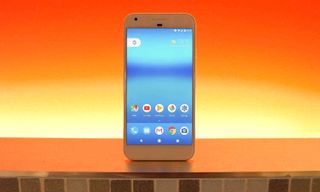
And while its peak brightness doesn't quite match on some Samsung or LG handsets, the Pixel XL produces rich colors and deep luscious blacks that made watching the space scenes in the latest Rogue One: A Star Wars Story trailer even more immersive.

We recorded the Pixel XL's max brightness at 393 nits, which is significantly dimmer than the Samsung Galaxy S7 Edge (530 nits), though still better than some other Android flagships, including the HTC 10 (371 nits) and the LG G5 (354 nits).
However, with a color range that covers 190.5 percent of the sRGB spectrum, the Pixel XL easily matched the superrich display on the S7 Edge (189 percent).

The one downside is that, a Delta-E of 5.88, the Pixel XL's color accuracy is just OK. (Lower numbers are better.) The S7 Edge's display earned a rating of 2.89, while the HTC 10 and the LG G5 scored 3.6 and 2.6, respectively.
Audio: Just good enough
Another frustrating design element is the phone's lack of front-facing speakers: Even with the phone's big lower chin, Google somehow couldn't find room for these. It's a wasted opportunity and a step backward from the dual front-facing setup of last year's Nexus 6P.

When I compared the Pixel XL and the Nexus 6P side by side while listening to Ratatat's "Cream on Chrome," I got even more annoyed. The Pixel XL gets about as loud as the 6P and produces less distortion at max volume. But because its sound comes from just one of the slots on its bottom, the Nexus 6P delivers a better overall listening experience.
OS and UI: A deeper, more helpful Android
One of the best things about owning a phone that comes directly from Google is the instant updates. There's no waiting around for carriers or manufacturers to push out Android updates three to six months after their official release, and there's no third-party crapware to bog down the OS.
While I'm still not sure about the new circular app icons in Android Nougat 7.1, everything else is a welcome addition. There are small enhancements, such as the Google Now widget on the top left of the home screen, the revamped app drawer that you can access by simply swiping up from the quick access bar, and new gesture controls that let you open the notifications tray by swiping down in the fingerprint sensor in back.
I'm also a big fan of the the new shortcut commands that let you long-press on apps such as YouTube, so you can launch straight into your subscriptions from the home screen or check your most recent texts in Google Messenger even faster. The new Night Mode is also pretty handy for helping to cut down on excess blue light from the display, which can make it harder to fall asleep at night.
As one of the first phones to feature Qualcomm's new Snapdragon 821 processor and 4GB of RAM, the Pixel XL absolutely flies.
Because this phone is all Google from top to bottom, if anything ever goes wrong, you can get expert help via either phone or chat just by hitting the Support tab in the Settings menu.
Unfortunately, because the company prefers virtual navigation buttons over capacitive ones, there's often a bar for Back, Home and Recent Apps, which cuts down on your usable screen real estate.
Performance: As swift as it gets
As one of the first phones to feature Qualcomm's new Snapdragon 821 processor in addition to 4GB of RAM and either 32GB or 128GB of storage, the Pixel XL absolutely flies. Then, you add the phone's general smoothness when opening up apps and navigating the UI, and you get the silkiest, stutter-free smartphone experience available on Android.

With a score of 4,146 on Geekbench 4, which measures overall system performance, the Pixel XL topped the S7 Edge's mark of 4,035 and blew past the Nexus 6P's score of 3,714.

The Pixel XL maintained its lead in the Jetstream 1.1 web browsing test, posting a score of 55.9, topping the S7's 49.9 and the Nexus 6P's 46.8. (Bigger numbers are better.)
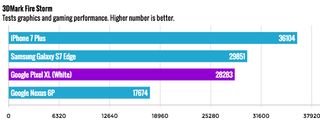
The one category where the Pixel XL didn't finish solidly ahead was on graphics, where Google's phone scored 28,283 versus the S7 Edge's 29,851 on 3DMark's Fire Strike graphics benchmark.
Battery Life: Enough for even the longest days
The Pixel XL offers very impressive endurance. On Verizon's LTE network, the phone lasted 10 hours and 34 minutes on our web surfing battery test. We saw even longer battery life on T-Mobile, where the phone lasted 11:48.

Those times compare favorably to other competing flagships, including the Galaxy S7 Edge (10:09), the iPhone 7 Plus (10:38) and the HTC 10 (9:56).
MORE: Smartphones with the Longest Battery Life
When compared to the Nexus 6P's battery life of 12:25, the Pixel XL falls short. However, in everyday use, not once did the Pixel XL conk out before I went to bed, and that was even after days of some pretty intense testing and benchmarking.
Bottom Line
Though the Pixel XL's uninspired appearance doesn't make the best impression, if you dig a little deeper, you'll see why Google's new top-to-bottom approach to smartphones makes so much sense. With total control over hardware and software, Google can deliver a swift, almost enlightened smartphone experience that makes the bugs and lack of updates you get on other Android phones seem pretty embarrassing.
After you add in an absolutely stunning camera, great battery life and the superhelpful Google Assistant, Google delivers a phone than it can be proud to call its own while giving Samsung's and Apple's flagship devices a run for their money.
Sign up to get the BEST of Tom’s Guide direct to your inbox.
Upgrade your life with a daily dose of the biggest tech news, lifestyle hacks and our curated analysis. Be the first to know about cutting-edge gadgets and the hottest deals.
Sam is a Senior Writer at Engadget and previously worked at Gizmodo as a Senior Reporter. Before that, he worked at Tom's Guide and Laptop Mag as a Staff Writer and Senior Product Review Analyst, overseeing benchmarks and testing for countless product reviews. He was also an archery instructor and a penguin trainer too (really).
